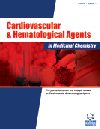- Home
- A-Z Publications
- Cardiovascular & Hematological Agents in Medicinal Chemistry (Formerly Current Medicinal Chemistry - Cardiovascular & Hematological Agents)
- Issue Home
Cardiovascular & Hematological Agents in Medicinal Chemistry (Formerly Current Medicinal Chemistry - Cardiovascular & Hematological Agents) - Current Issue
Volume 23, Issue 1, 2025
-
-
Sodium Butyrate, A Gut Microbiota Derived Metabolite in Type 2 Diabetes Mellitus and Cardiovascular Disease: A Review
More LessAuthors: Zeynab Sarlak, Narges Naderi, Bardia Amidi and Vajihe GhorbanzadehType 2 diabetes is characterized by elevated blood glucose levels, leading to an increased risk of cardiovascular diseases. Sodium butyrate, the sodium salt of the short-chain fatty acid butyric acid produced by gut microbiota fermentation, has shown promising effects on metabolic diseases, including type 2 diabetes and cardiovascular diseases. Sodium butyrate demonstrates anti-inflammatory, anti-oxidative, and lipid-loweri Read More
-
-
-
The Genus Anabasis: A Review on Pharmacological and Phytochemical Properties
More LessAuthors: Smail Amtaghri, Miloudia Slaoui and Mohamed EddouksThe genus Anabasis has long been used in phytomedicine. The studied parts of Anabasis species are used as antirheumatic, diuretic, antidotes against poison, anti-erosion, anti-ulcer, and antidiabetic agents, as well as against headache and skin diseases. The objective of the present review was to summarize the phytochemical and pharmacological aspects related to the genus Anabasis. The results of this literature analysis s Read More
-
-
-
Effect of Syzygium cumini on Oxidative Stress Induced Cardiac Cellular Anomalies
More LessAuthors: Renu Bhadana and Vibha RaniIntroductionDoxorubicin (Dox), an antineoplastic agent is used as a primary anti-cancerous drug against various types of cancers. However, its associated toxicity to the cardiovascular system is major. Literature has recorded the cases of mortality due to poor validation and lack of prediagnosis of Dox-induced cardiotoxicity. Therapeutic interventions using natural products having cardioprotective properties with low Read More
-
-
-
Early Prognostic Instrumental and Laboratory Biomarkers in Post-MI
More LessBackgroundPost-myocardial infarction (MI) changes have been frequently reported in the literature and are associated with determining the prognosis.AimsThe aim of this study is to find a prognosis marker for the favorability of determination of the medium-term outcomes in patients with acute MI.ObjectivesMI patients’ prognosis is poorly understood and requires further elaboration.Materials and MethodsA single cent Read More
-
-
-
Correction of Warfarin Coagulopathy for Non-bleeding Patients in the Outpatient Setting at an Ambulatory Care Organization: Application of Vitamin K Guidance
More LessAuthors: Aaminah Khan, David DeiCicchi, Peter Collins, Ashwini Ranade and Kathy ZaikenBackgroundWarfarin is an effective anticoagulant but requires close International Normalized Ratio (INR) monitoring and may occasionally require correction of excessive anticoagulation. Current guidelines provide limited practical guidance on the administration of vitamin K for the management of supratherapeutic INR levels ≥ 5.0 in non-bleeding outpatients.ObjectivesBased on expert consensus and guidelines, the Read More
-
-
-
Sildenafil Effect on Atrial Natriuretic Peptide Level in Pulmonary Hypertensive Rats
More LessAuthors: Mukhallad A. Aljanabi, Nasr Alrabadi, Sahar H. Mahmoud, Razan Haddad and Karem H. AlzoubiBackgroundPulmonary Hypertension (PH) leads to changes in pulmonary vascular architecture, hypertrophy of the right ventricle, and heart failure. Sildenafil is a drug that can modulate PH by inducing smooth muscle relaxation and vasodilation.AimsTo investigate the ability of sildenafil to alleviate the monocritaline (MCT)-induced PH in rats and to estimate the role and its effect on the atrial natriuretic peptide (ANP) levels. Read More
-
Volumes & issues
-
Volume 23 (2025)
-
Volume 22 (2024)
-
Volume 21 (2023)
-
Volume 20 (2022)
-
Volume 19 (2021)
-
Volume 18 (2020)
-
Volume 2 (2020)
-
Volume 17 (2019)
-
Volume 16 (2018)
-
Volume 15 (2017)
-
Volume 14 (2016)
-
Volume 13 (2015)
-
Volume 12 (2014)
-
Volume 11 (2013)
-
Volume 10 (2012)
-
Volume 9 (2011)
-
Volume 8 (2010)
-
Volume 7 (2009)
-
Volume 6 (2008)
-
Volume 5 (2007)
-
Volume 4 (2006)
Most Read This Month Most Read RSS feed
Article
content/journals/chamc
Journal
10
5
false
en


